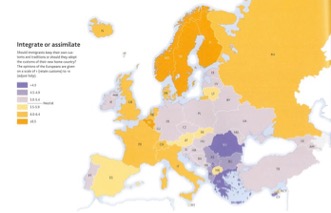Sign up for FlowVella
Sign up with FacebookAlready have an account? Sign in now
By registering you are agreeing to our
Terms of Service
Loading Flow

Integration and Assimilation
Welcoming foreigners is one thing, the degree of integration and ultimately assimilation quite another. Think about your own ideas about the desired degree of adaptation.
Response
Integration is adaptation to the (national) norms of another state in the public domain, reserving the right to keep your own culture in the private domain. Assimilation implies that the person in question thinks and acts as the other nationals; s/he is actually no longer a foreigner (although appearances may still result in prejudices).
However, the public debate is has a rather emotional overtone. The Atlas of European Values contains the map on the left. “Should immigrants keep their own customs and traditions or should they adopt the customs their new home country?” The opinions of the Europeans are given on a scale of 1 (retain customs) to 10 (adjust fully). The colours (from purple to orange) indicate <4.5, 4.5-4.9, 5.0-5.4, 5.5-5.9, 6.0-6.4 and ≥ 6.5.
Minorities
Please define the conditions for welcoming minorities in your country or denying them access.
Response
Against a backdrop of interdependency and sovereignty states conclude treaties, including the UNHCR treaty, outlining who should be granted asylum. At the other end of the scale foreigners are quite often welcomed for a period of a couple of years; e.g. representatives of foreign companies or diplomats.
The discussion often focuses on the in-between categories. What do we do with people who need some kind of protection but are not in danger in the sense of asylum seekers? And what to do with people who come to your states in pursuit of a better life? And what do you do when the labour market shows a shortcoming in supply in a certain sector?
Your own opinion on these matters is influenced by the cultures you are part of (or have been). In the opposite direction: your opinion says something about your culture.
Exercises
